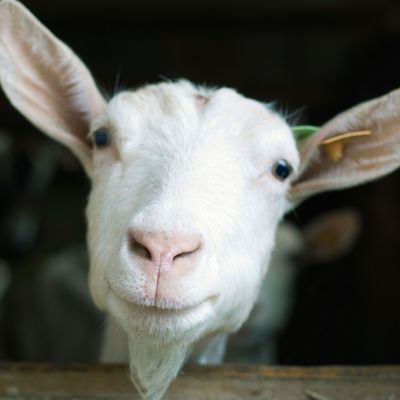
There exists a Twitter account that is 100 percent devoted to goats — that, in fact, is the name of this particular account: 100% Goats. To cityfolk like myself, the behavior of the goats featured on the feed is often astonishingly doglike, with the animals cuddling with their humans or going on suburban walks. Who knew these little barnyard creatures were so animated, so interested in the people around them?
Well, fine, this is likely something people with much more goat experience than I had did, in fact, know. Another group that already knew this, and went ahead and wrote about it in the journal Biology Letters: a trio of researchers from Queen Mary University of London. Their study, published earlier this year, found some intriguing evidence of certain behavior in goats that looks a lot like behavior in dogs, something that suggests that — as The Guardian phrased it — “goats are on a similar domestication trajectory to dogs.”
The experiment was similar to one that’s been done in a variety of animals — not just dogs, but wolves and cats, too, as well as human toddlers. It goes like this: The animals (or the little people) are presented with an impossible-to-open box, which clearly stores a treat inside. After messing with it for a minute, dogs and toddlers tend to look to the person stationed nearby, as if to say, “Help, please.” Cats, as they do, mostly ignore the humans when presented with this task; wolves don’t bother looking to people for help, either. But goats? Goats, the researchers note, acted a lot like dogs, their gazes turning to the nearby person after a few frustrated attempts to open the box themselves.
This finding complicates the dogs-as-man’s-best-friend narrative, Jenna Kiddie — who was not involved in this study but does study animal behavior and welfare at Anglia Ruskin University — told The Guardian. It makes intuitive sense that dogs, unlike wolves, would look to people for help. “Dogs evolved to follow our gaze because we needed them to be good hunting dogs,” Kiddie said. “We’ve never had any social need from goats apart from their meat and milk, so this research really throws that into the water.”
It’s not clear exactly why the goats in this study might have responded the way they did, but The Guardian suggests one potential explanation: Goats are curious creatures, driven to explore and interact with their surroundings much more than many of their barnyard counterparts (namely, the comparatively shyer sheep). Even so, it’s not clear from this study whether all goats would necessarily respond in the same way; the three dozen-ish goats used in this study were from the idyllic-sounding Buttercups Sanctuary for Goats, and thus had experienced many positive previous interactions with people. I, for one, will be anxiously awaiting more research on this subject to help me continue to craft a very important argument: that a goat would make for a very nice pet and I should definitely be allowed to keep one in my apartment.




